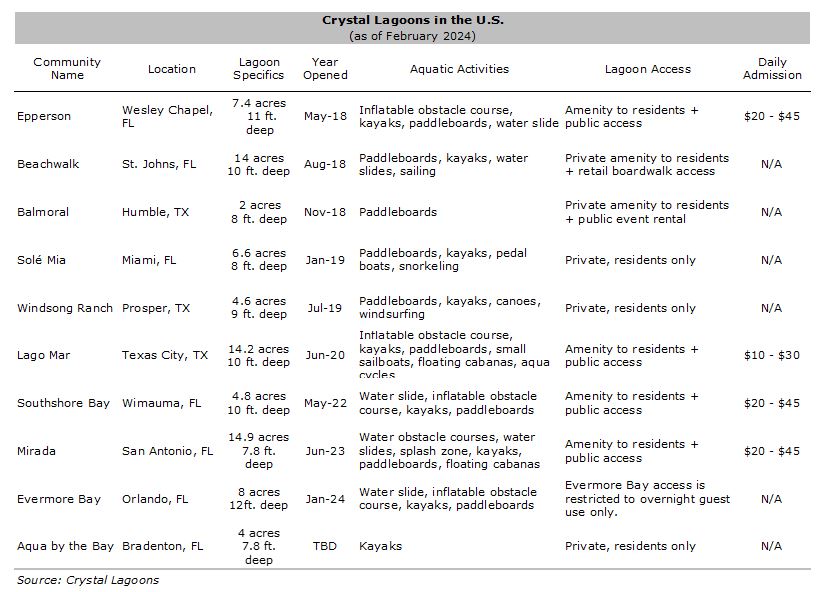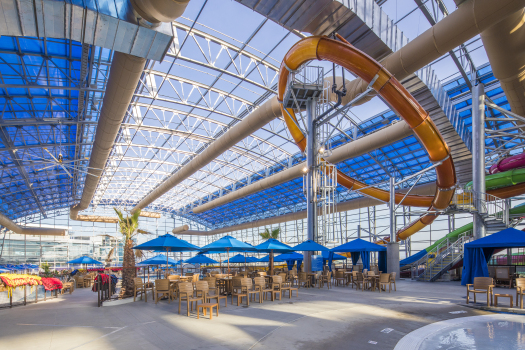By: Stephen Szczygiel, CHIA
Man-made swimming lagoons, not to be confused with pools or waterparks, have emerged as a new and innovative way to enjoy recreational water activities. These large (over one acre of water surface) and uniquely designed aquatic venues present new opportunities within the residential, resort, and attractions industries. Over the past several years, H&LA has seen the emergence of swimming lagoons in many facets of leisure development from large-scale resort settings to residential developments.
The rise in popularity of these man-made lagoons lies in their ability to create waterfront and beach-like experiences without the necessity of proximity to a lake or ocean. They are designed to replicate the natural features of lagoons, including the shoreline and water depth variations, to create a unique and attractive environment that enhances the overall quality of life for residents or attracts visitors to a particular leisure area. This has opened entirely new development opportunities for residential and leisure properties to capitalize on this emerging and fast-growing trend. The lagoons can be marketed as day-use attractions or waterparks and achieve strong revenue in addition to homeowners’ association (HOA) fees from adjacent residences.
THE TECHNOLOGY
The technology behind leisure-oriented man-made lagoons involves a combination of engineering, water management systems, and smart technologies to create and maintain an attractive and functional recreational environment. While several companies offer lagoon variations, Crystal Lagoons was the pioneer of the technology that put man-made lagoons on the map.
Crystal Lagoons’ patented technology allows crystalline lagoons of nearly unlimited sizes to be built and maintained at low costs, using a minimum amount of chemicals and energy. The lagoons use up to 100 times fewer chemicals than conventional swimming pools and about 2% of the energy. The technology’s ultrasound devices emit a frequency into the water that causes suspended dirt and particulates to clump together, reducing filtration to just 1% of the body of water. The lagoons can operate with any type of water – salt, fresh, or brackish – based on local availability. Altogether, the lagoons use up to 30 times less water than a golf course and one-half as much water as a land park of the same size.
In addition to Crystal Lagoons, there are a number of competitors within the expanding market. Some of these competitors include Cloward H20, Oasis Amenities, Fluidra, Blue Mar Basins, VVater, Aquatic Development Group, and others.
FEATURES OF MAN-MADE LAGOONS
- Size and Scale: Man-made leisure lagoons are often vast in size, providing a sense of expansiveness and escape. Ranging from a minimum of one acre to over 20 acres, these lagoons offer a unique opportunity for users to experience the tranquility of a natural setting without leaving their current environment.
- Water Quality and Conservation: State-of-the-art water treatment systems ensure the highest water quality, making the lagoons suitable for swimming, kayaking, and other water-based activities. Additionally, many developments prioritize water conservation by implementing sustainable practices such as rainwater harvesting and advanced filtration systems, minimizing environmental impact.
- Technological Integration: Man-made leisure lagoons leverage technology to enhance the overall experience. Smart sensors monitor water quality, temperature, and crowd density, ensuring a safe and enjoyable environment. Advanced lighting systems and augmented reality features may also be integrated to create immersive experiences for visitors.
- Surrounding Amenities: Man-made lagoons are often part of larger mixed-use developments, featuring a variety of amenities such as waterfront promenades, parks, restaurants, and recreational facilities. This holistic approach creates vibrant communities that offer a well-rounded lifestyle for residents.
COMMERCIAL DEVELOPMENT
Over the past several years, residential and resort mixed-use developments have added man-made lagoons across the United States. As of February 2024, developers have opened nine Crystal Lagoon communities in two states – Florida and Texas – with others currently under development in the Coachella Valley of California and Bradenton, Florida. The following table summarizes information on these lagoon communities.
Of the operational Crystal Lagoons in the United States, four offer access to the public through the sale of day passes. Other notable planned man-made swimming lagoons set to open in 2024 include:
- Thermal Beach Club will feature a 20-acre private swimming lagoon that offers authentic inland surfing as well as other leisure water recreational activities to the residents of the 326 luxury homes surrounding the development. This simulated ocean experience is being designed and engineered by Florida-based Martin Aquatic Design & Engineering using the company’s patent-pending Blue Mar Basins system. The development will be in the greater Palm Springs, California, area and is estimated to be upwards of a billion-dollar project.
- Angel Lagoon is a public access Crystal Lagoon facility being developed in Dayton, Texas, as part of a 40-acre mixed-use entertainment district. The lagoon had its official groundbreaking in November 2023 and is scheduled to open in the summer of 2024. It will include several themed beaches including a family beach, adult beach, VIP beach, and entertainment beach. The facility will include a palapa, performance lawn and stage, food truck plaza, synthetic turf celebration lawn, watersports facility, boat docks, beach volleyball courts, swim-up bar, hammock lawn, and VIP cabanas.
- OKANA Outdoor Adventure Lagoon is part of the $400 million OKANA Resort that will feature an 11-story, 404-room hotel with rooms featuring riverfront and lagoon views and proximity to downtown Oklahoma City and the Boathouse District. The 4.5-acre outdoor adventure lagoon designed by Aquatic Development Group is planned to be the center for relaxation and play at the property. The resort also will feature a 12,000-square-foot family entertainment center, a two-level indoor waterpark covering 100,000 square feet, 39,000 square feet of conference center space, a spa, amphitheater, a golf simulator, and an additional 36,000 square feet of retail outlets and dining options adjacent to the resort.
According to our research, there are over 100 lagoons with various technology providers in the planning stages of development across the United States.
BENEFITS OF MAN-MADE LAGOON DEVELOPMENT
The development of man-made swimming lagoons offers a multitude of both quantitative and qualitative benefits, contributing to enhanced real estate values and fostering a sense of community pride.
Quantitative Benefits
- Increased Real Estate Values: Proximity to a well-designed swimming lagoon often leads to increased property values. Homes and properties located near such amenities are typically more attractive to potential buyers, resulting in higher demand and subsequently elevated real estate values. According to Crystal Lagoons, Epperson, the first public-access lagoon that opened in 2018 in Wesley Chapel, Florida, saw home sale prices increase by 21% during pre-construction with the addition of the lagoon, while competitors only managed to increase prices by 1-5%.
- Economic Stimulus: The construction and maintenance of swimming lagoons contribute to local economic growth. Jobs are created during the development phase, and ongoing operations require staffing, generating employment opportunities within the community.
- Revenue Generation: Many man-made swimming lagoons are designed as recreational facilities that may charge entry fees or offer memberships. This revenue stream not only supports the maintenance of the lagoon but also contributes to local government funding or community development initiatives. Many of these fees help to offset and reduce annual homeowners’ association dues for residents of lagoon communities.
- Activities: Lagoons may offer a range of waterpark-type activities, including waterslides, boat rentals, beaches, surf areas, restaurants, bars, reception and picnic areas, wedding gazebos, and more.
- Tourism and Hospitality Boost: Attractively designed swimming lagoons can draw tourists and visitors to the area, boosting the local hospitality industry. Hotels, restaurants, and other businesses benefit from increased foot traffic, further enhancing the economic landscape. These benefits can be observed in increased occupancy and average daily rate (ADR) for hotels with rooms boasting views of lagoons, as well as increased ticket prices for activities surrounding the lagoons. According to a Crystal Lagoons study prepared by STR, first-line hotels, those having waterfront views, experience 150% premiums in RevPAR and TRevPAR.
Qualitative Benefits
- Community Pride: A well-maintained man-made swimming lagoon becomes a focal point for community activities and events, fostering a sense of pride among residents. It can serve as a symbol of community development and a source of local identity. Many existing lagoon developments host private resident events, charitable functions, and weddings, with the lagoons being the epicenter of these gatherings.
- Recreation and Well-Being: The availability of a swimming lagoon provides residents and visitors with a recreational outlet, promoting physical activity and overall well-being. This contributes to a healthier and happier community.
- Social Cohesion: The presence of a communal space like a swimming lagoon encourages social interactions among residents. Community events, gatherings, and recreational activities help build stronger social bonds, fostering a sense of belonging.
OUTLOOK
Lagoon amenities from Crystal Lagoons and other manufacturers are riding a wave of popularity in the United States. While the lagoons are expensive to develop – costing roughly $1 million or $1.5 million an acre – developers recognize their unique and tangible benefits, including strong demand among home buyers, renters, visitors, and residents. Though these lagoons may face challenges related to scalability, reliability, and maintenance, this has not dampened enthusiasm for development opportunities.
The development of man-made swimming lagoons not only has tangible economic benefits but also significantly contributes to the intangible aspects of community development, creating a more vibrant, attractive, and connected living environment. However, as the industry progresses from its infancy stage, developers, operators, and technology providers face several potential concerns that warrant careful consideration. Disputes over intellectual property have caused some recent challenges as the development and implementation of new technologies for man-made swimming lagoons have brought into question intellectual property rights surrounding filtration technology.
Lastly, the introduction of man-made swimming lagoons to the public requires an educational component to inform potential visitors about the benefits, technology, and recreational components of these lagoons. Different man-made lagoon projects have had varying levels of expected performance, influenced by factors such as design, technology, and management. Managing and meeting diverse expectations from stakeholders, including residents, visitors, and local authorities, is crucial for the success of these developments.
Addressing these concerns, while capitalizing on the growth in popularity, requires a proactive and strategic approach from all stakeholders involved in the development and operation of man-made swimming lagoons. Open communication, legal diligence, ongoing education, and a commitment to resolving challenges are essential to ensure the sustained growth and positive impact of this evolving and exciting industry. A thorough market feasibility study should be performed to analyze the potential usage, revenues, expenses, net income, and value for a proposed lagoon development.
AUTHOR
Stephen Szczygiel, CHIA, is a Senior Associate at Hotel & Leisure Advisors (H&LA), an international hospitality consulting firm. H&LA specializes in appraisals, feasibility studies, impact analyses, economic impact studies, and litigation support for hotels, resorts, waterparks, surf parks, attractions, casinos, conference and convention centers, golf courses, ski resorts, and other leisure real estate. Prior to joining Hotel & Leisure Advisors, Stephen held various management positions with Hilton, XfinityLive!, and Penn National Gaming. Stephen earned his Bachelor of Science in Hotel and Restaurant Management, with a focus on Casino Operations, and Minor in Business Administration from Drexel University in addition to studying Culinary Arts at The Restaurant School at Walnut Hill College in Philadelphia. He can be reached via telephone at 216-810-5801 or via e-mail at sszczygiel@hladvisors.com.



